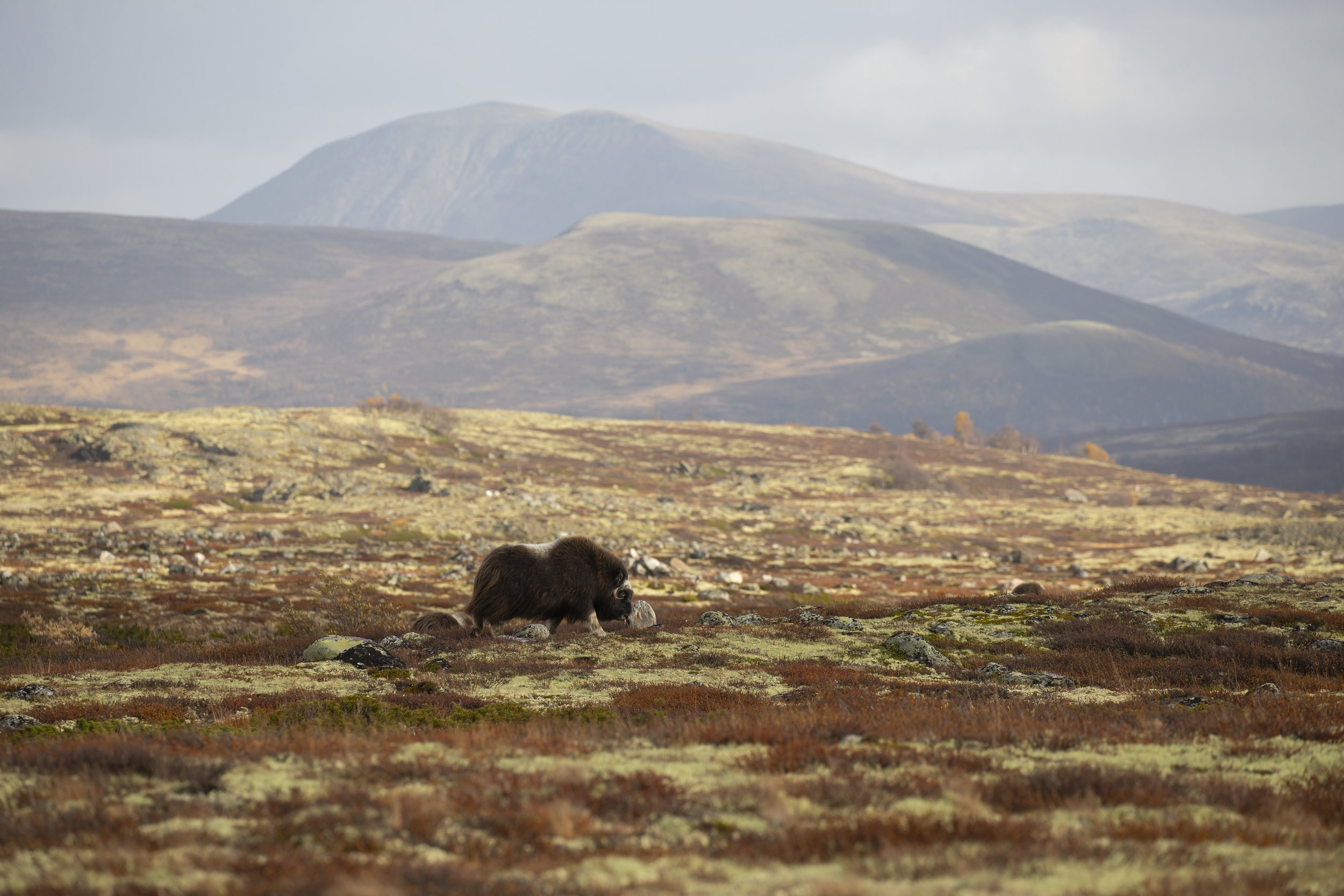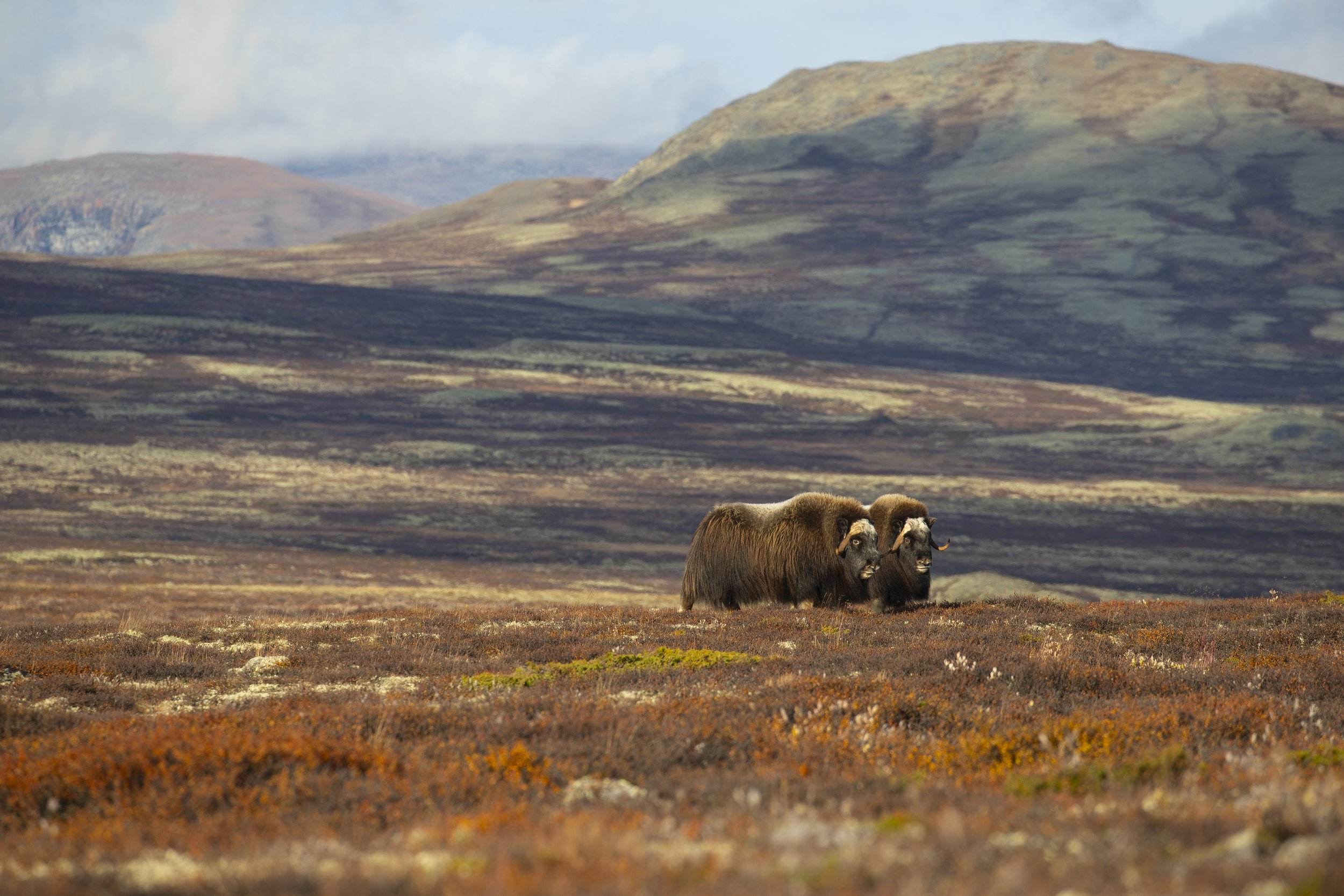January 2024
On the scent of Musk Ox
Musk Ox have always been on my list to experience and photograph. They are such intriguing and seemingly ancient creatures, you truly can see how they may not have changed much in many, many generations. Superbly adapted to their harsh environments in the northern hemisphere. My first impressions of musk ox were of course from the incredible BBC Natural History Unit films. In a solidly frozen Greenland, their flagship Attenborough series’ provided stunning cinematography, it makes me shiver at the thought of it.
Those curious faces blinking in the blizzard, ice stuck to their eyelashes, hanging in strings from their beards and puffing clouds of steam from their wide nostrils, plumes and swirls of cloud, the only give away that they weren’t totally frozen solid. Then the explosive panic turning to solid defiance as wolves enter the frame. I knew I would be unlikely to be able to photograph them in this situation, so when the chance to find them in slightly more hospitable conditions in Norway appeared I had no hesitation to head there.
Particularly, I wanted to find them in autumnal colours. The area of Dovrefjell in central Norway at this time of year seems like a huge tapestry of colours and textures all interwoven on a vast canvas of rolling mountains and plateaux. Texture is something that is ever apparent with musk ox, it is after all, their incredible shaggy coats and rough cut horns that give them their biggest appeal to me. If I were brave enough, I’d love to delve into that curtain-like fur although I suspect that might not be welcomed. In Dovrefjell, what appears at first glance to be a vast and barren landscape is anything but. The landscapes of Norway are always spectacular wherever you go and here is just the same. The plateau here is dotted with bog, heath, peaty streams, bare rocks, craggy cliffs, lichens, moss, birch, and berries - it’s a really rich botanical area. A superbly interesting ecosystem of which the musk ox now form an integral part, a natural feature in this landscape.
The population here are not native, although musk ox probably were in the past as they date back to before the last ice age - they are part of a successful reintroduction from the early 1930s, following the discovery of some musk ox vertebrae during excavation for the railway. Carefully managed now to preserve the health and balance of the population as well as that of the wider environment, the musk ox population in Norway is regulated to around 200-250 individuals.
Despite being more readily accessible than other musk ox populations, they still present a challenge to wildlife photographers in this rugged terrain, they certainly keep you fit and are not so easy to spot despite their size. Living in family herds, they move with surprising speed and cover the ground so swiftly. My fantastic guide, Floris, took some time lapse film of them when we were out and its really fascinating to see how they move and different herds interact.
The guy below is a great example. Suddenly, he upped and left his herd behind. Literally marching with quite a swagger and with undeniable purpose to grumble and bellow at another male who was out of sight, challenging somewhere over the mountain ridge. It was of course the time of the rut, so the males perhaps were a little more angsty than usual. His point made, he swiftly returned to his group where he was greeted by one of the tiny baby bulls, who was in sheer admiration!
For me, it was really exciting to see that he was most definitely scenting the air, from the few days I was lucky enough to observe these magnificent beasts, it was clear that scent plays a big role in their lives. I suppose that should come as no surprise given their name. I have to admit to not having had one whiff of them myself though. You can also see a cow in the images below sniffing around a rock that was being used as a scratching post and again a scent marking post, fascinating stuff as a behavioural ecologist who spent years studying scent marking in mammals. Musk ox scent mark using a pre orbital gland as well as urine (probably the source of the disgusting smell during the rut, much like red deer I imagine) and presumably faeces in the environment.
Photographically, the environment was something that I really wanted to capture on this trip, I am glad I only took my 100-400mm lens out and about and exclusively used this to make me work that little bit harder. To really think about the composition, what was in the background? and to incorporate both the habitat and weather/lighting in the scene as a whole. It would have been easy to have zoomed in for a full frontal with a larger lens but that wasn’t my intention although I’ll be lying if I said I didn’t have envy of my friends’ kit when we were in the field.
The musk ox were really kind to us, accommodating our hours of voyeurism, the weather - a mixed bag as to be expected, but boy does that make for some really interesting shots, the light conditions changing in an instant, much of the time sat with a ‘wow’ face on, just from the sheer magic of the Norwegian landscape, let alone the brilliant beasties in front of us. I just loved being there, to be immersed in the light, the land, the mountain air - fresh and clean - I gulped in lungfuls with the delight normally reserved for a good of a glass of red, and all with the most fabulous company too. Let’s do it again!













